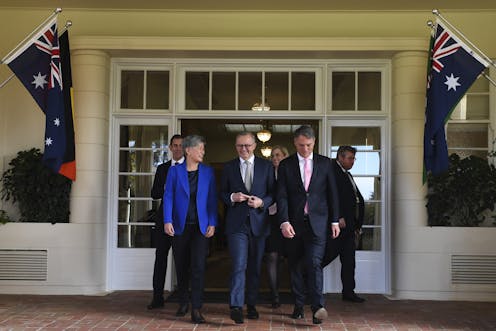Why Labor is likely to win a House of Representatives majority despite a 33% primary vote
- Written by Adrian Beaumont, Honorary Associate, School of Mathematics and Statistics, The University of Melbourne

With 73% of enrolled voters counted, the ABC is calling[1] 73 of the 151 House of Representatives seats for Labor, 54 for the Coalition, 15 Others and nine in doubt. Labor is likely to win Lyons, while the Coalition should win Bass, Cowper and Sturt. The Coalition is currently just ahead in both Deakin and Gilmore.
Labor would need to win two of the three other undecided seats if they miss out on Deakin and Gilmore. The Coalition will lose Brisbane to either Labor or the Greens. Current primary votes there are 37.0% Coalition, 28.0% Greens and 27.8% Labor. Whichever of Labor and the Greens goes out first elects the other on preferences.
Macnamara and Richmond are both Labor-held seats that the Greens are threatening. In both seats, Labor currently has a primary vote lead over both the Greens and the Coalition. If it’s Labor vs Greens, Labor wins on Coalition preferences. If it’s Labor vs Coalition, Labor wins on Greens preferences.
Labor only loses these seats if they finish third after minor candidates are distributed (a “three candidate preferrred”). The ABC rates both Richmond and Macnamara as likely Labor. If they win both these seats and Lyons, they reach the magic 76 seats needed for an outright House majority. But we may not know for sure until after the June 3 deadline for reception of postals.
Current primary votes[2] are 35.8% Coalition (down 5.7% since 2019), 32.8% Labor (down 0.5%), 11.8% Greens (up 1.5%), 4.9% One Nation (up 1.8%), 4.2% UAP (up 0.7%) and 10.5% for all Others (up 2.2%). The ABC’s two party estimate is 51.9-48.1 to Labor, a 3.4% swing to Labor.
Disproportionate single-member system
Why is Labor likely to win a house majority even though their national primary vote is down 0.5% from the 2019 election to just 32.8%? Australia uses a single member system for the house, and such systems are disproportionate.
If Labor wins a majority, it would be because they finish in the top two in the overwhelming majority of seats, and then win a large share of preferences whether their opponent is the Coalition or the Greens, as Coalition how to vote cards put Labor ahead of the Greens.
The one situation where Labor will not do well on preferences is when facing an independent. Had Labor’s national primary vote been higher, Kristina Keneally may have survived in Fowler[3].
Here are two examples from the UK of very disproportionate outcomes from first past the post with single-member electorates. In 2005[4], Labour defeated the Conservatives by 35.2% to 32.4% nationally with 22.0% for the Liberal Democrats. But Labour won 355 of the 646 House of Commons seats (55% of seats).
In 2015[5], the Conservatives defeated Labour nationally by 36.8% to 30.4% with 12.6% UK Independence Party and 7.9% Lib Dems. The Conservatives won 330 of the 650 Commons seats (51% of seats).
Single-member systems are very landslide-prone, and there have been two recent Australian state elections where one of the major parties has nearly been wiped out of the lower house of parliament.
At the Queensland 2012 state[6] election, the LNP defeated Labor by 49.7% to 26.7% on primary votes and by 62.8-37.2 after preferences. The LNP won 78 of the 89 seats and Labor just seven. But Labor recovered to win the 2015 Queensland election.
At the Western Australian 2021 election[7], Labor crushed the combined Liberals and Nationals by 59.9% to 25.3% on primary votes and 69.7-30.3 after preferences, resulting in a lower house of 53 Labor, four Nationals and just two Liberals.
An argument can be made that single-member systems shut out minor parties and provide stable government. But if you want a more proportional outcome, you need a proportional system, not a single-member system.
Issues with the count
The Australian Electoral Commission[8] (AEC) provides a live two party count that currently has Labor ahead by 52.2-47.8. But this excludes all the seats where Labor and the Coalition were not the final two candidates.
There will be a special Labor vs Coalition count in all these seats in a few weeks, once the main results are finalised. I believe the ABC uses the swing in the seats currently counted between Labor and the Coalition to project the national two party.
On election night, there were many seats where the AEC selected the wrong two candidates for the final count. These counts need to be re-done with the correct candidates. But early votes counted between the correct candidates are often unrepresentative of the overall primary votes in that seat.
For example, the initial preference count in Ryan[9] was between the Coalition and Labor, and this is now being re-done between the Coalition and Greens. The AEC still has the Coalition just ahead, but the ABC applies preference[10] flows to the full primary votes, giving the Greens a 53.2-46.8 lead.
References
- ^ ABC is calling (www.abc.net.au)
- ^ primary votes (www.abc.net.au)
- ^ Fowler (tallyroom.aec.gov.au)
- ^ 2005 (en.wikipedia.org)
- ^ 2015 (en.wikipedia.org)
- ^ Queensland 2012 state (en.wikipedia.org)
- ^ Western Australian 2021 election (en.wikipedia.org)
- ^ Australian Electoral Commission (tallyroom.aec.gov.au)
- ^ Ryan (tallyroom.aec.gov.au)
- ^ ABC applies preference (www.abc.net.au)

















